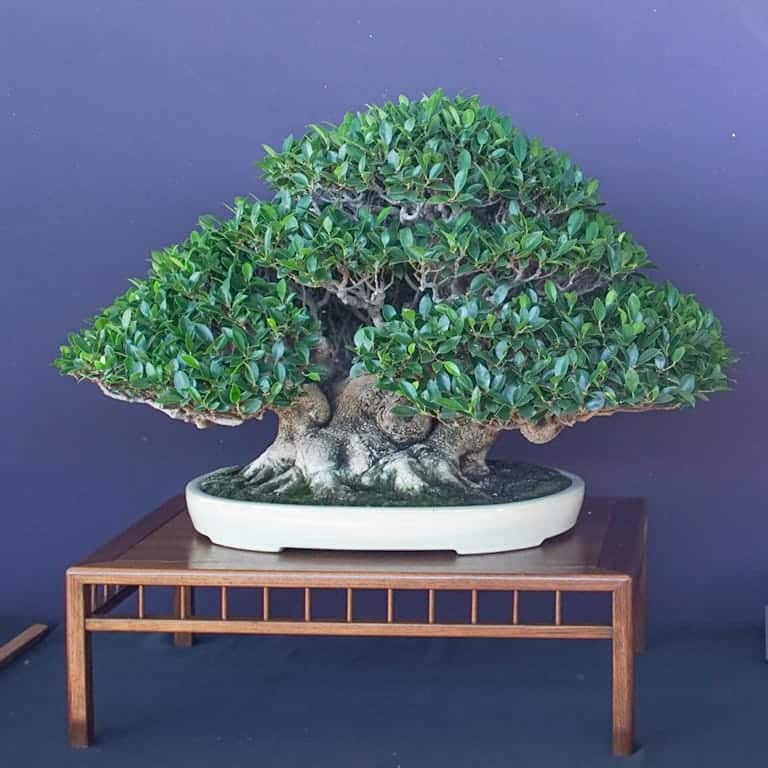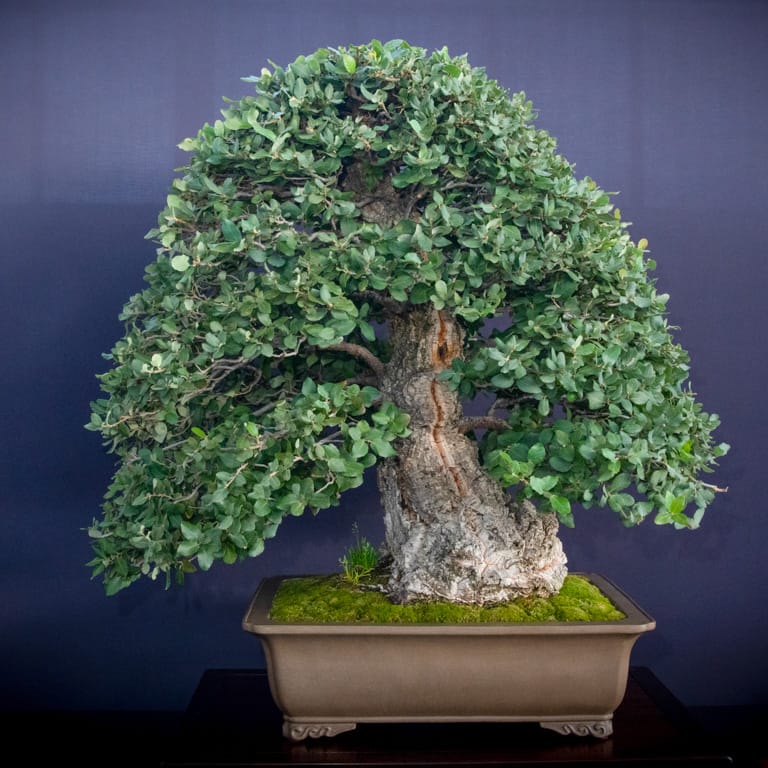Let’s look at two of the more impressive broadleaf evergreens in the Expo, a ficus and a cork oak.

Chinese Banyan Tiger Bark Ficus by Jeff Stern
Image courtesy Julian Tsai

Cork Oak by Michael Roberts
Image courtesy Vince Smith
Both trees scored well in the judging – here are the details:
Tiger bark ficus: overall rank: 17 of 73; total points: 154; average score: 3.85
Cork oak: overall rank: 25 of 73; total points: 149; average score: 3.725
With forty judges awarding between one and five points each, only five points separated the two trees – a close call!
I think both trees deserve a score of 4, give or take a point, as they are both above average considering the other bonsai in the exhibit. The ficus has superior branch development and surface roots while the cork oak has great presence and conveys age with its fissured bark.
What might bump one tree over the other? The judges considered the containers, stands, accents, and overall displays. In terms of the trees themselves, tree age, preparation, development, surface roots, branches, and silhouette came into play.
Harder to define characteristics might be things like how well a tree exemplifies its species. For example, is the ficus a better ficus than the cork oak is a cork oak? Put another way, what are our expectations for ficus bonsai (fantastic branch branch density, sinuous feeling) versus our expectations for cork oaks (great bark on the trunk and primary branches) and how does each tree score among other examples of the species.
Beyond that we’re getting into personal biases for trees or styles we simply like or don’t like.
I’ve found that the prize winners at Japanese exhibits almost always convey great age. Whether the age is expressed through the bark, the branch density, or the fullness of the silhouette, the winners looks like they’ve been bonsai for a long time.
By that standard both trees score well, and yet both can improve with time!
Speaking of time, we’re looking at requiring that exhibit trees sit out the next exhibit before they’re eligible for display again. This means the cork oak is ineligible for display at the second Expo in 2024 but that it can be shown at the third Expo in 2026.
For award-winning trees, we’re requiring that they sit out the next two exhibits before they can be shown again. That means that the fourth Expo (in 2028) will be the next opportunity for the ficus to appear in the Expo.
I hope you found this info about bonsai evaluation helpful. If you’d like to see more write-ups like this, let me know in the comments below.
News and Updates
For more photos, video, and audio from the Expo, see the Valavanis and Crataegus bonsai blogs, the Bonsaify and Baikoen Bonsai YouTube channels, and the Bonsai Wire podcast.
Valavanis Bonsai Blog
- Pacific Bonsai Expo – Part 1
- Pacific Bonsai Expo – Part 2
- Pacific Bonsai Expo – Part 3
- Pacific Bonsai Expo – Part 4
- Pacific Bonsai Expo – Bonus Part 5
Crataegus Blog: Photo Gallery: Pacific Bonsai Expo ‘22
Bonsaify on YouTube: How big is Naka’s bird?
Baikoen Bonsai on YouTube
- Pacific Bonsai Expo 2022
- Artists’ Highlight at the Pacific Bonsai Expo 2022
- Vendors Area of the Pacific Bonsai Expo 2022
- Award Winning Trees at the Pacific Bonsai Expo 2022
Bonsai Wire Podcast: Pacific Bonsai Expo Recap
For some non-Expo-related news, Andrew Robson and I are hosting a Shohin Seminar in Milwaukie, Oregon, on January 28-29, 2023. The event features headliner Daisaku Nomoto from Miyazaki, Japan. Saturday we’ll study shohin display and Sunday we’ll focus on shohin design and development.
Select vendors will be on hand with shohin containers and pre-bonsai. Enrollment is limited to 100 participants. Learn more at Shohinschool.com.
Subscribe to Bonsai Tonight
New Posts Delivered Every Tuesday and Friday
Marianne Yamaguchi says
Yes more write-ups please! Always interesting Jonas!
Jonas Dupuich says
Thanks, Marianne – will do!